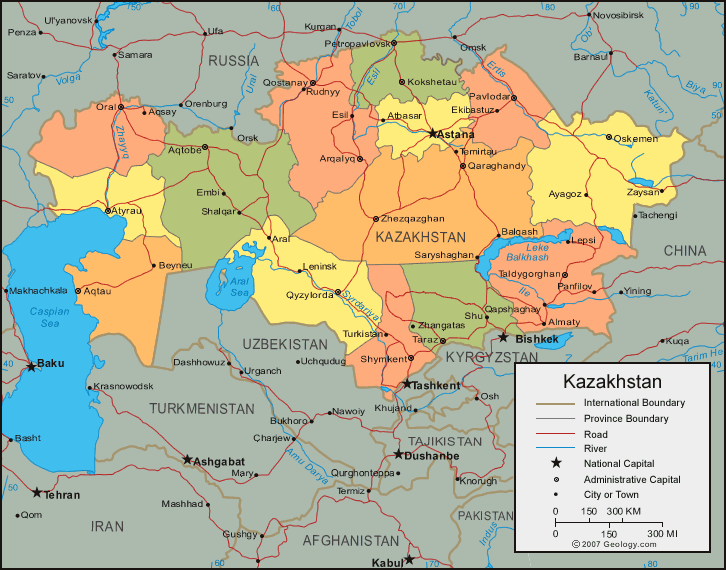

 The Republic of Kazakhstan, is a transcontinental country in Central Asia and Europe. The ninth largest country in the world by land area, it is also the world’s largest landlocked country. Its territory is 2,727,300 square kilometers that is larger than Western Europe. While located primarily in Asia, a small portion of Kazakhstan is also located west of the Urals in Eastern Europe.
The Republic of Kazakhstan, is a transcontinental country in Central Asia and Europe. The ninth largest country in the world by land area, it is also the world’s largest landlocked country. Its territory is 2,727,300 square kilometers that is larger than Western Europe. While located primarily in Asia, a small portion of Kazakhstan is also located west of the Urals in Eastern Europe.
It is neighbored to Russia, China,Kyrgyzstan, Uzbekistan, Turkmenistan, and also has borders on a significant part of the Caspian Sea. Although Kazakhstan does not share a border with Mongolia, its most easterly point is only 38 kilometers from Mongolia’s western tip.
The terrain of Kazakhstan ranges from flatlands, steppes, taigas, rock-canyons, hills, deltas, and snow-capped mountains to deserts. The terrain of Kazakhstan extends west to east from the Caspian Sea to the Altay Mountains and north to south from the plains of Western Siberia to the oases and deserts of Central Asia. The Kazakh Steppe, with an area of around 804,500 square kilometers. It is the world’s largest dry steppe region occupies one-third of the country, characterized by large areas of grasslands and sandy regions. Important rivers and lakes include: the Aral Sea, Ili River, Irtysh River, Ishim River, Ural River, Syr Darya, Charyn River and gorge, Lake Balkhash and Lake Zaysan.
The climate is continental, with warm summers and colder winters. Precipitation varies between arid and semi-arid conditions.
Following the estimation of year 2011 the population of Kazakhstan is about 16.6 million people that are less than 6 people per square kilometer. Major cities include Astana, Almaty, Karagandy, Shymkent, Atyrau and Oskemen. In year 1998 the capital was moved from Almaty to Astana the largest city of Kazakhstan.
For most of its history, the territory of modern-day Kazakhstan has been inhabited by nomadic tribes. By the XVI century, the Kazakhs emerged as a distinct group, divided into three Jüz. The Russians began advancing into the Kazakh steppe in the XVIII century, and by the middle of XIX century all of Kazakhstan was part of the Russian Empire. Following the 1917 Russian Revolution, and subsequent civil war, the territory of Kazakhstan was reorganized several times before becoming the Kazakh Soviet Socialist Republic in 1936, a part of the USSR.
as a distinct group, divided into three Jüz. The Russians began advancing into the Kazakh steppe in the XVIII century, and by the middle of XIX century all of Kazakhstan was part of the Russian Empire. Following the 1917 Russian Revolution, and subsequent civil war, the territory of Kazakhstan was reorganized several times before becoming the Kazakh Soviet Socialist Republic in 1936, a part of the USSR.
Kazakhstan declared itself an independent country on December 16 year 1991. It was the last Soviet republic done it. Its leader, Nursultan Nazarbayev, became the country’s first president and retains its position till nowadays. Since independence, Kazakhstan has pursued a balanced foreign policy and worked to develop its economy, especially its hydrocarbon industry. Kazakhstan increased its involvement with many international organizations, including the United Nations, the Euro-Atlantic Partnership Council, the Commonwealth of Independent States, and the Shanghai Cooperation Organisation. Kazakhstan is also one of six post-Soviet states who have implemented an Individual Partnership Action Plan with NATO.
Kazakhstan is ethnically and culturally diverse, with 131 ethnicities, including Kazakh, Russian, Uyghur, Ukrainian, Uzbek, Tatar, and German. Around 63% percent of the population is Kazakhs. Kazakhstan allows freedom of religion, and many different beliefs are represented in the country. Islamis the religion of more than 70% of the population, with Christianity practiced by most of the remainder. The Kazakh language is the state language, while Russian is also officially used as an equal language to Kazakh in Kazakhstan’s public institutions.
Because of the livestock was central to the Kazakhs’ traditional lifestyle, most of their nomadic practices and customs relate in some way to livestock. Kazakhs have historically been very passionate about horse-riding. Traditional curses and blessings invoked disease or fecundity among animals, and good manners required that a person ask first about the health of a man’s livestock when greeting him and only afterward inquire about the human aspects of his life. Even today, many Kazakhs express interest in equestrianism and horse-racing.
More information about Kazakhstan and its life you could see on: www.kazakhstan.com and